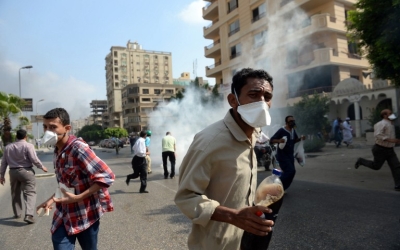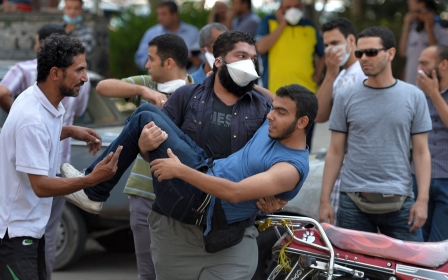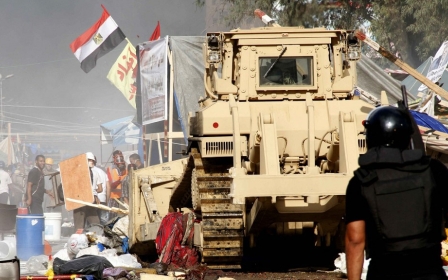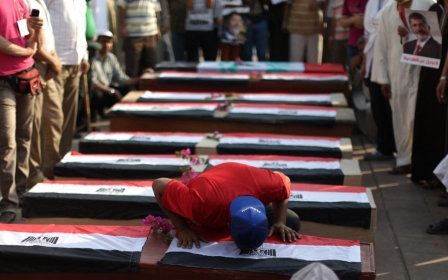
There were bodies as far as the eye could see. Remembering the Rabaa massacre
Jehan Maher Aql can remember every detail of the massacre as if it happened yesterday.
Some of the bodies were charred beyond recognition, she says. Many took sniper fire to the head.
Others had gunshot wounds on their bodies.
Eleven years ago today, in the early hours of 14 August 2013, Egyptian security forces stormed Cairo's Rabaa and al-Nahda squares and massacred at least 900 pro-democracy protesters in one of the largest killings of demonstrators in a single day in Egypt's modern history.
The violent crackdown came six weeks after then-General Abdel Fatah el-Sisi seized power from Egypt's first democratically elected president, Mohamed Morsi.
New MEE newsletter: Jerusalem Dispatch
Sign up to get the latest insights and analysis on Israel-Palestine, alongside Turkey Unpacked and other MEE newsletters
A leading member of the Muslim Brotherhood organisation, Morsi was elected into office a year after Egypt's 2011 revolution, which forced longtime autocrat Hosni Mubarak from power and sparked an unlikely series of events that swelled, then dashed, hopes of democracy in the region.
Over the course of six weeks, thousands of protesters converged at the Rabaa and al-Nahda squares to demand Morsi's reinstatement and a return to the democratic process that was vigorously fought for just two years earlier.
Many of the estimated 85,000 protesters were said to be members of the Muslim Brotherhood, but a sizeable number were also non-partisan civilians opposed to the coup.
'The bullets rained down on us from every side'
- Jehan Maher Aql, Rabaa survivor
Among the attendees were women, children and the elderly.
On 13 August, the square was teeming with activity - with bouncy castles, a swimming pool and food stalls just metres away from the sit-in area.
But just a day later, there was blood "everywhere". "Bodies as far as the eye could see."
"The bullets rained down on us from every side," Aql told Middle East Eye, as she painfully recalled the horrific moments when men, women and children were gunned down around her.
"I never thought I would leave the square alive. I genuinely thought, 'this is the end'."
'Ugly and violent'
Weeks earlier, before he launched his coup, Sisi, who had been appointed by Morsi as defence minister and head of the armed forces, warned that his forces would have to intervene as anti-government protests and counter-demonstrations rocked the country.
"We are fully responsible for protecting the will of the great Egyptian people," Sisi said. "The armed forces have never tried to intervene in public affairs or politics. But I would like to say that we all have a moral, national, and historic responsibility.
"We will not accept that Egypt enters a dark tunnel of conflict, internal strife, civil war, or collapse of state institutions," he added.
What would happen next is often described as the end of Egypt's democratic transition.
Following the coup, supporters of the military grew angry and frustrated with the defiant sit-in, and calls to disperse them came from both largely pro-military private and state-owned media outlets.
The military-backed government ordered the dispersals of Rabaa and al-Nahda on 14 August, with a convoy of armoured military vehicles shutting down all major exits to the square, one of Cairo's busiest thoroughfares.
"[We knew] they (Egyptian forces) would come [into the square] and beat us up, but for the dispersal to be this vicious, ugly and violent - this is something we never expected. We never thought that we would see such a thing in Egypt," she said.
Egyptian authorities had initially promised a gradual dispersal of the protest and said they would provide safe exits for people to leave the square.
The actual dispersal, however, was the exact opposite.
'Thin line between life and death'
In the span of 12 hours, from sunrise to sunset, security forces and snipers fired live ammunition on large crowds of protesters, as armoured personnel carriers (APCs) blocked every point leading to Cairo's Rabaa al-Adawiya square.
Using the armoured vehicles, snipers and live ammunition, Egyptian forces would kill at least 817 people at Rabaa and another 87 at al-Nahda Square, according to Human Rights Watch.
Other rights groups have put the number as high as 2,600, as hundreds of protesters still remain unaccounted for.
"We were sitting in our tent, and then the bullets flew over our heads," Aql told Middle East Eye. "One hit a child who was sitting with us. It was at that point I realised the thin line between life and death."
Attacks were carried out from all five entrances to the square, making it lethal for trapped protesters to try and leave the square or for the wounded to be transported to hospitals. Many of those who tried to escape were shot dead.
"One of the scenes I will never forget is when we entered the mosque, the windows were closed and mothers and children were locked inside to protect them from the [tear] gas being fired outside," said Aql.
"We were all standing while the men were carrying dead bodies and piling them up. Among the dead was a young man who I can never forget. They were carrying him legs first, but as they walked by we saw there was no head.
"How could they kill someone like this? How did they blow his brains out?" she added.
Then-Interior Minister Mohamed Ibrahim later admitted in a TV interview that he had anticipated at least 2,000 fatalities among the protesters during the dispersal.
This was echoed by then-Prime Minister Hazem Beblawi, who also said in an interview that "the final outcome was less than we expected".
For survivors like Aql, it doesn't feel like a decade has passed.
She says she, like many other survivors, is haunted by the images of that day, when death was everywhere.
Tamarod was exploited
Despite a wealth of evidence implicating the Egyptian army in the killings, no one has ever been brought to trial and the Egyptian government has yet to transparently investigate the massacre.
The government-appointed National Council of Human Rights (NCHR) produced a report on the events, but its findings are at odds with witness accounts and human rights activists.
On Monday, a draft report by the NCHR was finally leaked online, with the document saying that "it was possible to end the sit-in without the bloodshed".
"This file must be reopened by a committee composed of investigating judges ... so that the public can stand on the truth in order to preserve the unity of the homeland and to prevent this political division from turning into a social division that threatens the unity of the state," the report, authored in 2014, said.
The United States, which has long supported the Egyptian military, has accepted Sisi's rise and continues to provide Cairo with crucial military funding. Two weeks before the killings, US Secretary of State John Kerry even described developments following the coup as a "restoration of democracy".
Shorouq Amjad, an activist and former Tamarod member, said while she didn't regret initiating the protests against Morsi, it was clear the movement was exploited by the Egyptian military's top brass.
Tamarod, which loosely translates to "rebellion" or "insubordination", claimed to have collected the signatures of a staggering 22 million Egyptians, an outlandish claim which somehow managed to unite the opposition and mobilise a large number of Egyptians against Morsi's government.
The groups' founders had initially emphasised their interest in bringing politics back to the Egyptian people. But allegations have swirled whether the group was created by Egyptian intelligence to counter the Muslim Brotherhood.
"At that time we were young, and we were driven by enthusiasm," Amjad told MEE, adding that the movement "did not understand politics" and was not aware of the army's role in manufacturing unrest.
"The movement was exploited," Amjad added. "At first, we started with a few young men, most of whom were from the revolution [against Mubarak], and were calling for early presidential elections.
"But with the passage of time, we started seeing new faces that we knew nothing about."
It was, she later realised, part of a process in which the army and security officials began exerting influence over Tamarod, seizing upon the group's reputation as a grassroots revolutionary movement to pursue their own agenda.
Leaked audio recordings have also alleged that the Tamarod's leadership was drawing on a bank account administered by Egypt's generals and replenished by the United Arab Emirates.
Torture is rife
In 2014, after a year-long investigation, Human Rights Watch concluded that the killings at Rabaa "were part of a policy" and "likely amounted to crimes against humanity".
"The Rabaa massacre precipitated a devastating campaign of arrests, sham trials, torture, and exile that has all but removed any space for critical dialogue and pushed many reformists out of the country," said Adam Coogle, the deputy Middle East and North Africa director at HRW.
"Addressing what happened in Rabaa does not only concern Rabaa victims and their families, but is also crucial for the prospect of human rights and democracy in Egypt."
Civil society in Egypt has been dealt a crippling blow since Sisi came to power, with the crackdown on the political opposition effectively precluding the establishment of real political parties, and restrictions on non-governmental organisations (NGOs) enshrined by a law deliberately aimed at curtailing their operations.
The law bans activities such as public opinion polls and field research without government approval and empowers the government to dissolve NGOs that operate against restrictive government regulations.
Most independent human rights groups have left Egypt and operate from abroad for fear of being prosecuted.
According to the now-shuttered Arabic Network for Human Rights Information, the total number of prisoners in Egypt in March 2021 was 120,000, with an estimated 65,000 political prisoners - at least 26,000 of them still being held in pre-trial detention.
There is no official tally of the number of political prisoners, and the Sisi government denies holding any dissidents in jail.
Many of those who are arbitrarily detained are subjected to enforced disappearances, which has become a "systematic practice" under Sisi's rule, according to the Committee for Justice.
Meanwhile, rights groups have accused authorities of maintaining a policy of medical negligence, torture and ill-treatment of political prisoners, resulting in the deaths of hundreds of people since 2013.
Torture remains a widespread practice by the security services. International media outlets have published several revelations about torture in places of detention, but none of the incidents have been investigated by authorities and the perpetrators remain at large.
Middle East Eye delivers independent and unrivalled coverage and analysis of the Middle East, North Africa and beyond. To learn more about republishing this content and the associated fees, please fill out this form. More about MEE can be found here.






